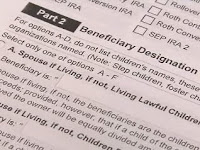Two
Slott Report Mailbags in one week?! Yes, we are here a day earlier than normal to answer a few consumer questions (they are piling up) on IRA rollovers, IRA beneficiaries and naming minors as IRA beneficiaries. Remember to send your questions to
[email protected].
As
always, we stress the importance of working with a competent,
educated financial advisor to keep your retirement nest egg safe and
secure. Find one in your area at this link.
1.
What is the most tax efficient way to reinvest funds that have been received from a beneficiary IRA account that must be distributed by the 5-year mark. I received a rather large amount from my father in his Traditional IRA, but because I am rather young I would like to preserve as much of the balance of his IRA as I can while still paying out the 20% I will owe on required minimum distributions (RMDs). Any ideas?
Answer:
The death distributions you receive from your dad’s IRA are taxed as ordinary income when received. There is no 10% early distribution penalty on distributions made to beneficiaries. Taking out the funds gradually over 5 years would lessen the taxes you’ll owe versus taking a lump-sum distribution. As a non-spouse beneficiary you cannot avoid the taxes by rolling the funds over to your own IRA.
Because you are young, you might consider using the funds to make annual Roth IRA contributions, limited to $5,000 per year, assuming you have earned income which does not exceed certain limits (e.g., $110,000 for a single filer for 2012). The interest earned by those Roth IRA contributions then would have many years to compound tax-free and would result in a nice nest egg for your retirement. You should consider consulting with a financial advisor for options on investing the balance of the funds you will receive.
Your situation is a reminder that IRA owners should be sure to have named beneficiaries for their accounts. Named beneficiaries have the option to take distributions over their life expectancies and are generally not forced to take out the entire balance over five years.
2.
Hello,
Neither my husband or I are working.
My husband is 61 and we are living primarily on withdrawals from his rollover IRA. I am 57. If my husband were to die before I am 59 1/2, would I owe the 10 percent penalty for money I would need to access from his IRA? I am the sole beneficiary. Would I need to keep it separate from my own IRA?
Thank You!
Jan Schilling
Answer:
You would not owe the 10% penalty so long as you do not make his IRA your own IRA before you turn age 59 ½. After his death, you would leave the IRA in an inherited or beneficiary IRA because death distributions, while taxable, are exempt from the 10% early distribution penalty regardless of your age at the time of the withdrawal.
A beneficiary IRA must be kept separate from your own IRA. Once you turn age 59 ½, you could then make that IRA your own IRA.
3.
I would love to leave my Roth IRAs to my grandchildren as stretch IRAs, but I hear that most young people who inherit an IRA cash it out immediately and spend it, thus losing the advantage of the stretch. I guess that the temptation of a quick payout of money is too much for them, or they don't understand or care about the advantage of the stretch IRA. Is there any way to structure a future inherited IRA to prevent this from happening?
Or, is it possible to leave an IRA to a trust that mandates minimum distributions, or defines a payout schedule, thus preserving the concept of a stretch IRA? How would the RMD be calculated, as the trust doesn't have a life expectancy?
Answer:
The law mandates that after you die, your Roth IRA beneficiaries must take death distributions using either the five-year rule or single life expectancy (stretch IRA). They can take a lump-sum withdrawal at any time. The only way to control the disposition of IRA funds after your death is to have a trust named as the beneficiary (like you mentioned). If the trust meets certain rules, called the look-through rules, then the required minimum distribution (RMD) will be calculated using the age of the oldest beneficiary of the trust.
This is a very complicated area of planning. You need to use advisors with knowledge of both the IRA and the trust rules. You can find a listing of Ed Slott- trained advisors on our website,
www.irahelp.com.
-By Joe Cicchinelli and Jared Trexler  IRAs pass to beneficiaries through the beneficiary form. They don't pass by way of your will unless you name your estate as your beneficiary or sometimes, in what should never be the case, if you fail to name any beneficiaries at all. They also never get to your trust unless you name your trust as your beneficiary. You could have the best trust in the world in place to receive distributions from your IRA after your death, but if you don’t file a beneficiary form naming that trust as your beneficiary, it will never see any IRA distributions.
IRAs pass to beneficiaries through the beneficiary form. They don't pass by way of your will unless you name your estate as your beneficiary or sometimes, in what should never be the case, if you fail to name any beneficiaries at all. They also never get to your trust unless you name your trust as your beneficiary. You could have the best trust in the world in place to receive distributions from your IRA after your death, but if you don’t file a beneficiary form naming that trust as your beneficiary, it will never see any IRA distributions.


















